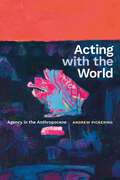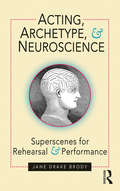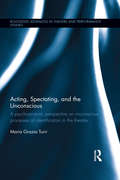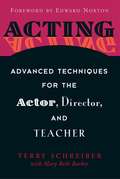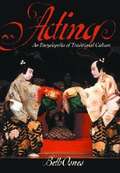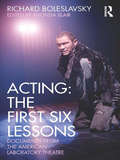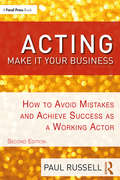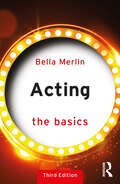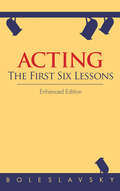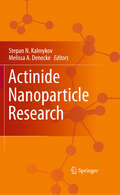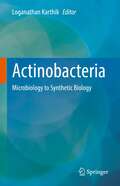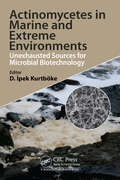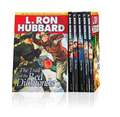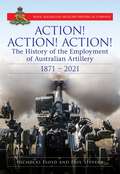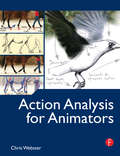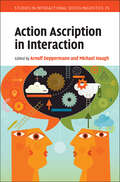- Table View
- List View
Acting with the World: Agency in the Anthropocene
by Andrew PickeringIn the Anthropocene our actions are coming home to roost. Global warming, species extinctions, and environmental disasters are the dark side of our mastery of nature. In Acting with the World, Andrew Pickering identifies a different pattern of being and doing that can evade this dark side, a pattern that he calls acting-with the world. In contrast to our usual practice of acting on the world, acting-with foregrounds nonhuman or more-than-human agency and aims to attune our practices to the propensities of nature. Pickering explores examples of acting-with from around the globe, including flood control on the Mississippi River, ecosystem restoration on the Colorado River, the Room for the River project and rewilding in the Netherlands, natural farming in Japan, Aboriginal fire techniques in Australia, and Amazonian shamanism. Pickering argues that acting-with intimately and gracefully plugs us into nature, undercuts the Anthropocene from below, and offers a constructive approach to addressing otherwise intractable wicked problems.
Acting, Archetype, and Neuroscience: Superscenes for Rehearsal and Performance
by Jane Drake Brody"How do we move actors into the less accessible regions of themselves and release hotter, more dangerous, and less literal means of approaching a role?" Superscenes are a revolutionary new mode of teaching and rehearsal, allowing the actor to discover and utilize the primal energies underlying dramatic texts. In Acting, Archetype, and Neuroscience Jane Drake Brody draws upon a lifetime’s experience in the theatre, alongside the best insights into pedagogical practice in the field, the work of philosophers and writers who have focused on myth and archetype, and the latest insights of neuroscience. The resulting interdisciplinary, exciting volume works to: Mine the essentials of accepted acting theory while finding ways to access more primally-based human behavior in actors Restore a focus on storytelling that has been lost in the rush to create complex characters with arresting physical and vocal lives Uncover the mythical bones buried within every piece of dramatic writing; the skeletal framework upon which hangs the language and drama of the play itself Focus on the actor’s body as the only place where the conflict inherent in drama can be animated. Acting, Archetype, and Neuroscience weaves together a wealth of seemingly disparate performance methods, exciting actors to imaginatively and playfully take risks they might otherwise avoid. A radical new mixture of theory and practice by a highly respected teacher of acting, this volume is a must-read for students and performance practitioners alike.
Acting, Spectating and the Unconscious: A psychoanalytic perspective on unconscious mechanisms of identification in spectating and acting in the theatre. (Routledge Advances in Theatre & Performance Studies)
by Maria Grazia TurriFrom Aristotle’s theory of tragic katharsis onwards, theorists of the theatre have long engaged with the question of what spectatorship entails. This question has, directly or indirectly, often been extended to the investigation of acting. Acting, Spectating, and the Unconscious approaches the unconscious aspects of spectatorship and acting afresh. Interweaving psychoanalytic descriptions of processes such as transference, unconscious phantasy, and alpha-function with an in-depth survey of theories of spectating and acting from thinkers such as Brecht, Diderot, Rousseau and Plato, Maria Grazia Turri offers a significant insight into the emotions inherent in both the art of the actor, and the spectator’s experience. A compelling investigation of the unconscious communication between spectators and actors, this volume is a must-read for students and scholars fascinated by theatre spectatorship.
Acting: Advanced Techniques for the Actor, Director, and Teacher
by Edward Norton Terry Schreiber Mary Beth BarberHoned by the author's 35 years of teaching, this advanced book offers different warm-up exercises concentrating on the actor's sense of smell, sound, sight, and touch; sensory tools for conveying the climate and environment of the text; tips for suggesting a character's physical conditions; and much more. Individual exercises will help actors to free the voice and body, create a character, find the action and condition of scenes, and explore the subconscious for effective emotional recall. Readers will also find meticulous guidelines for best using rehearsal time and preparing for in-class scene work. The foreword is written by two-time Academy Award nominee Edward Norton. Those who act, direct, or teach will not want to miss the acting lessons that have made T. Schreiber Studio a premier actor training program.
Acting: An International Encyclopedia
by Beth OsnesExpanding beyond the conventional western concept of theater, the reference explores current and historical rituals, festivals, and performances from countries and cultures around the world; contributions of women to acting and the performing arts; and cinema and the film industry. The cross-referencing is extensive, and entry-specific references augment the general bibliography.
Acting: Documents from the American Laboratory Theatre
by Richard Boleslavsky Rhonda BlairActing: The First Six Lessons was first published in 1933 and remains a key text for anyone studying acting today. These dramatic dialogues between teacher and idealistic student explore the field of acting according to one of the original teachers of Stanislavsky’s System in America. <p><p> This new edition of an essential text is edited by Rhonda Blair and supplemented for the very first time with documents from the American Laboratory Theatre. These collect together a broad range of exciting unpublished material, drawn from Boleslavsky’s pivotal and unprecedented teachings on acting at the American Laboratory Theatre.
Acting: How to Avoid Mistakes and Achieve Success as a Working Actor
by Paul RussellIn ACTING: Make It Your Business, Second Edition, award-winning casting director Paul Russell puts the power to land jobs and thrive in any medium—stage, film, television, or the Internet—directly into the hands of the actor. This blunt and practical guide offers a wealth of advice on auditioning, marketing, and networking, combining traditional techniques with those best suited for the digital age. Well-known actors and powerful agents and managers make cameos throughout, offering newcomers and working professionals alike a clear-eyed, uncensored perspective on survival and advancement within the entertainment industry. This second edition has been updated and expanded to include the following: More stars of screen and stage sharing acting career strategies Digital audition techniques for screen and stage, including how best to self-tape New tools to master modern marketing, both digital and traditional with innovation Expanded actor resource listings Additional bicoastal talent agents and managers spilling secrets for obtaining representation, and tips for successful actor-to-representation partnerships New insights on audition techniques An excellent resource for career actors, beginning and amateur actors, as well as students in Acting I and II, Auditions, and Business of Acting courses, ACTING: Make It Your Business provides readers with invaluable tools to build a successful, long-lasting acting career.
Acting: Onstage and Off (5th edition)
by Robert BartonDemonstrating how offstage performance can be effectively adapted for the theatre, as well as how onstage training can be applied toward leading a full life outside the theatre. ACTING: ONSTAGE AND OFF is a humorous yet informative book that discusses the interplay between life on and off the stage.
Acting: The Basics (The Basics)
by Bella MerlinNow in a vibrantly revised second editon, Acting: The Basics remains a practical and theoretical guide to the world of the professional actor, which skilfully combines ideas from a range of practitioners and linking the academy to the industry. Retaining a balance between acting history, a discussion of pioneers and a consideration of the practicalities of acting techniques, the new edition includes a discussion of acting for the screen as well as the practicalities of stage acting, including training, auditioning and rehearsing. With a glossary of terms and useful website suggestions, this is the ideal introduction for anyone wanting to learn more about the practice and history of acting.
Acting: The Basics (The Basics)
by Bella MerlinActing: The Basics 3rd Edition is a dynamic response to recent societal and entertainment industry changes, focusing on inclusion, diversity and equity, and the actor's trajectory from training to rehearsal to performance on stage and screen, with hands-on tools and global perspectives. The book offers vital ways of building a practical acting toolkit, through breath, body, voice, emotions, imagination and spirit. We begin with a socio-cultural look at actor as magician, storyteller, healer and social changer. Throughout, there are insights from Black, Indigenous, First Nations, South/East Asian, intercultural and feminist practitioners, together with methods focusing on disability and accessibility, intimacy directives, mindfulness and intersectionality. Key 'canonical' figures still feature (e.g., Stanislavsky, Meisner, Brecht and Suzuki) with re-visioned perspective. Scattered throughout are post-COVID insights, plus expanded sections on screen acting (including self-tapes) and Shakespeare. This book is useful for beginner or expert, as it's always helpful getting back to basics. Because the author is both an actor and an actor trainer, the tools are steeped in user-friendly application. At the same time, transferable skills (e.g., dynamic listening and empathy) are shown as relevant to everyone. With a glossary of terms and useful online suggestions (including blogs, videos and podcasts), this is ideal for anyone learn anew about the practice and history of acting, or to take their acting and teaching into new terrain.
Acting: The First Six Lessons
by Richard BoleslavskyActing: The First Six Lessons by Richard Boleslavsky is a classic and enduring guide to the art of acting, offering both aspiring and seasoned performers a deep understanding of the craft. Originally published in 1933, this book is structured as a series of dialogues between a young actress and an experienced director, through which Boleslavsky imparts essential lessons about technique, emotion, and artistic truth.The six lessons—Concentration, Memory of Emotion, Dramatic Action, Characterization, Observation, and Rhythm—form the foundation of Boleslavsky’s method, drawing from his experience in the Moscow Art Theatre and his study under Konstantin Stanislavski. Each lesson encourages actors to engage both mind and body, teaching them how to tap into personal emotions, create authentic characters, and bring nuance to their performances.Through vivid storytelling and insightful examples, Boleslavsky emphasizes the importance of discipline, empathy, and preparation in the actor’s journey. His conversational approach makes complex techniques accessible, guiding readers to explore their inner world, connect with their characters, and fully inhabit the roles they play. While deeply practical, the book also touches on the philosophical aspects of performance, encouraging actors to view their work as both a craft and a form of personal expression.Acting: The First Six Lessons remains a vital resource for actors, directors, and theater enthusiasts, offering timeless wisdom that continues to shape modern acting methods. Boleslavsky’s blend of technical instruction and artistic inspiration makes this book an essential addition to any actor’s library, challenging performers to approach their work with authenticity, emotional depth, and an unwavering commitment to truth.
Acting: The First Six Lessons
by Richard BoleslavskyThe classic text on the craft of Method acting by the founder of The American Laboratory Theatre.After studying at the Moscow Art Theatre under Konstantin Stanislavski, Richard Boleslavsky became one of the most important acting teachers of his or any generation. Bringing Stanislavski&’s system to America in the 1920s and 30s, he influenced many of the titans of American drama, from his own students—including Lee Strasburg and Stella Adler—to Marlon Brando, Paul Newman, and many others.In Acting: The First Six Lessons, Boleslavsky presents his acting theory and technique in a series of accessible and engaging dialogues. Widely considered a must-have for any serious actor, Boleslavsky&’s work has long helped actors better understand their craft.
Actinide Nanoparticle Research
by Melissa A. Denecke Stepan N. KalmykovThis is the first book to cover actinide nano research. It is of interest both for fundamental research into the chemistry and physics of f-block elements as well as for applied researchers such as those studying the long-term safety of nuclear waste disposal and developing remediation strategies. The authors cover important issues of the formation of actinide nano-particles, their properties and structure, environmental behavior of colloids and nanoparticles related to the safe disposal of nuclear wastes, modeling and advanced methods of characterization at the nano-scale.
Actinobacteria: Ecology, Diversity, Classification and Extensive Applications (Rhizosphere Biology)
by Jayachandra S. Yaradoddi Merja Hannele Kontro Sharanabasava V. GanachariThrough this book, the readers will learn about the different aspects of Actinobacteria- beginning with its ecology and occurrence, to the ways of its adaptation to harsh climates, and finally to its practical applications. The book also presents methods of identifying and characterizing this diverse group of bacteria through advanced techniques like MALDI-TOF, 16S rRNA analysis, etc. Different chapters describe the various biotechnological applications of Actinobacteria, including bioremediation, secondary metabolite production, and in producing antibiotics, anti-cancer therapeutics. It also provides insights into the applications in agriculture and forestry by inhibiting plant pathogenic bacteria's growth.
Actinobacteria: Microbiology to Synthetic Biology
by Loganathan KarthikThis book summarizes the basics of actinobacteria, from microbiology to synthetic biology. It focuses on diversity, NRPS, sesquiterpenes, lantipeptide, bioinformatics apparatuses, cloning, CRISPR, reverse engineering, FDA supported medications, and marine actinobacteria. It also covers the latest trends in drug discovery from actinobacteria, and introduces several recently developed bioinformatics and synthetic biology tools to explore new antibiotics from actinobacteria. Many natural products such as polyketides, isoprenoids, phenazines, peptides, indolocarbarbazoles, sterols, and others have been isolated and characterized from actinobacteria. Some products are synthesized by the non-ribosomal peptide synthetases (NRPSs), polyketide synthases (PKSs), or other functional genes. Although genome sequencing has uncovered the differing qualities of these chemicals, recognizing new items and their biosynthetic pathways is still under examination.Cryptic metabolic pathways have been explored using molecular techniques or culture-dependent approaches. In recent years, researchers’ primary interest is to identify the specific conditions or agents that wake the cryptic antibiotics. Several bioinformatics and synthetic biology tools were developed to explore new antibiotics from actinobacteria.The book comprises 14 chapters with different aspects of application and utilization of actinomycetes from the microbiology; systems biology, pharmacology of natural products, bioinformatics, actinomycete and its diversity, CRISPR, artificial Intelligence, synthetic biology, metabolic engineering, expressional studies, and biosynthetic gene clusters. The book delivers useful information on actinomyces to researchers, novices in genome designing, specialists, clinicians, policymakers, and professionals.
Actinomycetes in Marine and Extreme Environments: Unexhausted Sources for Microbial Biotechnology
by D. İpek KurtbökeThe discovery and development of antibiotics has been one of the most significant advances in medicine. In a golden era lasting from the 1940s to the late 1960s, antibiotic research provided mankind with a wide range of structurally diverse and effective agents for the treatment of microbial infections. Since then, actinomycetes, most notably members of the genus Streptomyces, have uninterruptedly proved to be a particularly rich source of antibiotics and other therapeutic and biotechnologically important compounds. This book brings together expert actinomycetologists to communicate the importance of finding novel antibiotic producing actinomycetes in extreme and marine environments in the light of molecular advances.
Action
by D. G. BrownProfessor Brown in this volume discusses one of the most difficult questions in metaphysics, "what is action?" His analysis proceeds along three main lines of thought: the point of view of the agent, the primacy of inanimate action, and the pervasiveness of explanatory insight in the description of action. In the spirit of recent work on practical reasoning, he takes the central fact about human action to be the existence of the point of view, and considers the agent's relation to his own body, Professor Brown argues that the concept of human action is best understood through that of inanimate action, such as the action of wind on trees or an axe on wood. His analysis takes inanimate action as fundamental, and defends it against the popular theory that it is an anthropomorphic projection. Human action is indeed unique. But it is also Professor Brown's thesis that the classical empiricist search for the brute fact of our own agency yields no more than incidental insights into its nature; introspection does not replace the analysis of human action.The analysis in this essay caters for inanimate action as well as for the uniqueness of human action. The key to an analysis complex enough to cover both is the notion of "attributability," which Professor Brown regards as providing "an Aristotelian extension of a Humean approach to causation." Explanation by reference to the soul exploits the point of view of the rational agent. In this way, both human and inanimate action are exhibited as natural phenomena the descriptions of which are pervaded by explanatory insight.The book as a whole gives an account of action in which the peculiarities of human action find their place in nature. It does not enter on questions of ethics, but remains with concepts common to morality, psychology, and history. There are incidental discussions of deliberation, psychokinesis, casual necessity, the agent's knowledge of his action, and responsibility. Here is a controversial theory of action supported by careful argument. Professor Brown's writing is both ambitious in scope and attentive to conceptual detail, and offers a valuable contribution to one of the liveliest contemporary debates in philosophy.
Action
by J. KrishnamurtiThe passages in this volume are taken from works by Krishnamurti. These include public talks, questions and answers, conversations, and writings. Krishnamurti always spoke from such a large perspective that his whole vision was implied in any extended passage, or sometimes by even a very short quote. Krishnamurti offers radically different answers to questions about relationships with others, and why we do not act with clarity and intelligence. He says, surely true action comes from clarity. When the mind is very clear, unconfused, not contradictory within itself, then action inevitably follows from that clarity.
Action & Adventure Collection, The
by L. Ron HubbardBreathtaking, pulse-pounding adventures that would put Indiana Jones on edge. Buckle up for adventure in these action-packed tales that appeared in the pages of the most popular pulp fiction magazines of the 1930's and 1940's. "Primo pulp fiction." --BooklistThe Collection includes:International Book Awards Winner: The Trail of the Red Diamonds as well as The Iron Duke, Sea Fangs, Golden Hell, The Headhunters and Destiny's Drum.
Action ART: HANDS-ON ACTIVE ART ADVENTURES
by Maryann F. Kohl Barbara ZaborowskiAction Art: Hands-On Active Art Adventures is A Collection of Over 100 Active Hands-On Art Experiences for Children 2-12, Full of Adventure, Movement, and Discovery. FOR SCHOOLS • HOMESCHOOLS • MUSEUMS• LIBRARIES • CHILDCARE • HOME Shelving: ART ACTIVITIES • EDUCATION • PARENTING Over 100 action-packed art activities bring discovery and adventurous creativity to children's art experiences that will delight and challenge kids of all ages. Each child-tested art activity is grouped into engaging action categories including: Smacking • Squeezing • Tapping Rolling • Spinning • Swinging Blowing • Exploding • Smooshing Tools • Toys • Utensils Up • Down • All Around Full color photographs highlight all activities including painting, photography, collage and sculpture, each with helpful icons indicating levels for both children and adults. Action Art experiences are built on the knowledge that art for children is a creative process and not just a finished product. MaryAnn Kohl is famous around the world for encouraging children to experience creative art exploration best known as "process art". Action Art offers 5 chapters of exciting and adventurous creative art activities, all with surprise outcomes, including – Blowing Glitter, Dancing Blottos, Bubble Wrap, Boot Walk, Clear Color Squish
Action Action Action: The History of the Employment of Australian Artillery 1871-2021
by Paul Stevens Nicholas FloydOver one hundred and fifty years ago, on 1st August 1871, the Colony of New South Wales raised its first permanent Battery, known as the New South Wales Artillery. This battery complemented existing colonial volunteer batteries. The previous year, the last British forces had departed for England, leaving the young, dynamic colonies across Australia to uphold their own defences. This occasion marked the origins of the substantive, permanent presence of professional Australian artillery soldiers – a presence that endures to this day as the Royal Regiment of Australian Artillery. In the years that have followed, Australian Gunners have served their country in war and in peace; abroad, and in the defence of their homeland, with honour and dedication, and will continue to do so into the future. 1st August 2021 marked a century and a half of unbroken dedication in the service of our community and the Nation by Australia&’s Gunners – Volunteer, Militia, Reserve, Permanent and Regular; at home, and in far-off lands; defending assaults from the sea, in the sky, and on land; and advising, defending and supporting our comrades-in-arms through summoning and orchestrating devastating fires and effects that are accurate, responsive, dependable & joint. These are, and will remain, the tenets of the Royal Regiment of Australian Artillery in all its forms. This is the story of Australia&’s Gunners – so far.
Action Analysis for Animators
by Chris WebsterAction Analysis is one of the fundamental princples of animation that underpins all types of animation: 2d, 3d, computer animation, stop motion, etc. This is a fundamental skill that all animators need to create polished, believable animation. An example of Action Analysis would be Shrek's swagger in the film, Shrek. The animators clearly understood (through action analysis) the type of walk achieved by a large and heavy individual (the real) and then applied their observations to the animated character of an ogre (the fantastic). It is action analysis that enabled the animation team to visually translate a real life situation into an ogre's walk, achieving such fantastic results.Key animation skills are demonstrated with in-depth illustrations, photographs and live action footage filmed with high speed cameras. Detailed Case Studies, practical assignments and industry interviews ground action analysis methodology with real life examples. Action Analysis for Animators is a essential guide for students, amateurs and professionals.
Action As An Organizer of Learning and Development: Volume 33 in the Minnesota Symposium on Child Psychology Series (Minnesota Symposia on Child Psychology Series #Vol. 33)
by Charles A. Nelson John J. Rieser Jeffrey J. LockmanThis is the 33rd volume in the Minnesota Symposium on Child Psychology held in October 2002. The symposium was held to honor the scientific and mentoring contributions of Anne Danielson Pick and Herbert L. Pick, Jr.--two longtime and beloved professors of the Institute of Child Development. It focused on "Action as an Organizer of Learning and Development" and integrated the best and most innovative research on the role of action in perceiving and understanding. Taken together, the book captures the intellectual excitement that characterized the 33rd symposium and appeals to developmental psychologists, particularly those interested in perceptual development.
Action Ascription in Interaction (Studies in Interactional Sociolinguistics #35)
by Michael Haugh Arnulf DeppermannBringing together a team of global experts, this is the first volume to focus on the ways in which meanings are ascribed to actions in social interaction. It builds on the research traditions of Conversation Analysis and Pragmatics, and highlights the role of interactional, social, linguistic, multimodal, and epistemic factors in the formation and ascription of action-meanings. It shows how inference and intention ascription are displayed and drawn upon by participants in social interaction. Each chapter reveals practices, processes, and uses of action ascription, based on the analysis of audio and video recordings from nine different languages. Action ascription is conceptualised in this volume as not merely a cognitive process, but a social action in its own right that is used for managing interactional concerns and guiding the subsequent course of social interaction. It will be essential reading for academic researchers and advanced students interested in the relationship between language, behaviour and social interaction.
Action At Third
by R. G. EmeryThis book will give a rare satisfaction to the person who knows baseball; and even the casually interested will be stimulated to a new appreciation of America's number-one sport. For Action At Third is more than merely sports fiction-- it is an expertly focused portrayal of defensive baseball, illustrated by a power-hitting team that learns, before it is too late, that good hitting will not always guarantee a win. Johnny Hyland, third baseman for the Dallas Hawks, plays common sense baseball; and he also has some unique ideas about how the Hawks can achieve the proper offensive-defensive balance. When manager Mitch Corey suffers from occupational ulcers, Johnny becomes the player-manager and gets his chance to make third base an outpost of strategy. His radical shake-up of the infield seems to defy accepted practice, and his bold defensive techniques are often bewildering--but they work with amazing success. The reader will admire Johnny's originality and applaud his courage, for this is baseball at its best. By the author of HYLAND OF THE HAWKS, etc.
